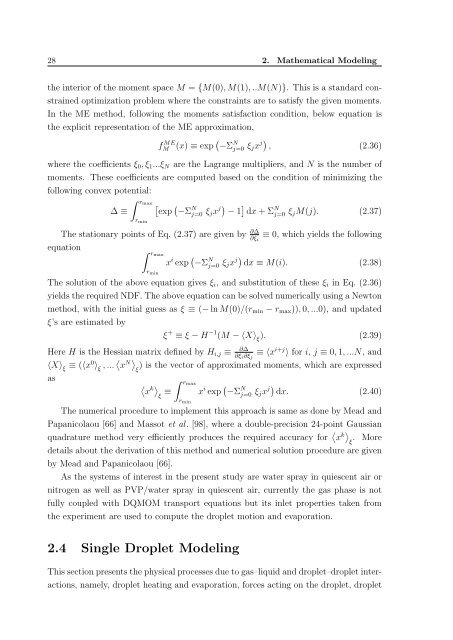INAUGURAL–DISSERTATION zur Erlangung der Doktorwürde der ...
INAUGURAL–DISSERTATION zur Erlangung der Doktorwürde der ...
INAUGURAL–DISSERTATION zur Erlangung der Doktorwürde der ...
You also want an ePaper? Increase the reach of your titles
YUMPU automatically turns print PDFs into web optimized ePapers that Google loves.
28 2. Mathematical Modeling<br />
the interior of the moment space M = {M(0), M(1), ..M(N)}. This is a standard constrained<br />
optimization problem where the constraints are to satisfy the given moments.<br />
In the ME method, following the moments satisfaction condition, below equation is<br />
the explicit representation of the ME approximation,<br />
f ME<br />
M (x) ≡ exp ( −Σ N j=0 ξ j x j) , (2.36)<br />
where the coefficients ξ 0 , ξ 1 ...ξ N are the Lagrange multipliers, and N is the number of<br />
moments. These coefficients are computed based on the condition of minimizing the<br />
following convex potential:<br />
∆ ≡<br />
∫ rmax<br />
r min<br />
[<br />
exp<br />
(<br />
−Σ<br />
N<br />
j=0 ξ j x j) − 1 ] dx + Σ N j=0 ξ j M(j). (2.37)<br />
The stationary points of Eq. (2.37) are given by ∂∆<br />
∂ξ i<br />
equation<br />
∫ rmax<br />
≡ 0, which yields the following<br />
r min<br />
x i exp ( −Σ N j=0 ξ j x j) dx ≡ M(i). (2.38)<br />
The solution of the above equation gives ξ i , and substitution of these ξ i in Eq. (2.36)<br />
yields the required NDF. The above equation can be solved numerically using a Newton<br />
method, with the initial guess as ξ ≡ (− ln M(0)/(r min − r max )), 0, ...0), and updated<br />
ξ’s are estimated by<br />
Here H is the Hessian matrix defined by H i,j ≡<br />
ξ + ≡ ξ − H −1 (M − 〈X〉 ξ<br />
). (2.39)<br />
∂∆<br />
∂ξ i ∂ξ j<br />
≡ 〈x i+j 〉 for i, j ≡ 0, 1, ...N, and<br />
〈X〉 ξ<br />
≡ (〈x 0 〉 ξ<br />
, ... 〈 x N〉 ) is the vector of approximated moments, which are expressed<br />
ξ<br />
as<br />
〈 〉 ∫ rmax<br />
x<br />
k ≡ x i exp ( −Σ N ξ j=0 ξ j x j) dx. (2.40)<br />
r min<br />
The numerical procedure to implement this approach is same as done by Mead and<br />
Papanicolaou [66] and Massot et al. [98], where a double-precision 24-point Gaussian<br />
quadrature method very efficiently produces the required accuracy for 〈 x k〉 ξ . More<br />
details about the <strong>der</strong>ivation of this method and numerical solution procedure are given<br />
by Mead and Papanicolaou [66].<br />
As the systems of interest in the present study are water spray in quiescent air or<br />
nitrogen as well as PVP/water spray in quiescent air, currently the gas phase is not<br />
fully coupled with DQMOM transport equations but its inlet properties taken from<br />
the experiment are used to compute the droplet motion and evaporation.<br />
2.4 Single Droplet Modeling<br />
This section presents the physical processes due to gas–liquid and droplet–droplet interactions,<br />
namely, droplet heating and evaporation, forces acting on the droplet, droplet













